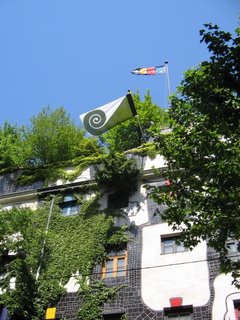We wandered down the popular shopping street of Mariahilferstrasse, and stopped into a boardgame store, Spielerei. We bought a small game called Hick Hack in Gackelwack (also known as Pick Picknic).
We caught the U-bahn out to an unusual building. The Hundertwasserhaus is a municipal apartment block in one of the most architectually uninteresting parts of Vienna. The artist Friedensreich Hundertwasser designed this building with several principles in mind: For example, tenants should be able to tell their apartment from the street so all the windows are different, and each apartment is painted a different colour. He also believed that a building shouldn't take land away from nature, hence the plants growing from the roof and out the sides of the building. He also put large golden onion domes on the roof because they are traditionally the perogative of the rich and powerful and he believed the tenants here deserved them, too.
We couldn't get into the building; it is a functional residential building, afterall. We still were able to marvel at surely one of the most unusual blocks of council flats.

One side of the Hundertwasserhaus.
A couple of blocks down the road is another building by the same artist, the Kunsthaus Wien, an art gallery. As it happens it was currently showing an exhibition of Hunderwasser's art, as well as an exhibition of HR Giger. Both exhibitions were very good. The Kunsthaus is obviously a natural and very fitting place to display Hunderwasser's work with its deliberately wonky floors, jarring colours and plants everywhere. Giger's work looked particularly dark in comparison.A particularly suprising display was an Australian flag that Hundertwasser had designed to replace the current one (he had also designed a flag for New Zealand which is quite popular). We bought a small version of this Australian flag in the gift shop as an unusual souvenir.

The Kunsthaus, with Hunderwasser's New Zeland flag flying.
Our last stop for the afternoon was another art gallery, the Secession Building. The purpose of the building is to give avant garde artists a space to display their work. The facade of the building, and Gustav Klimt's Beethoven Frieze in the basement are in Secession (Art Nouveau) style, but everything else was contempory art.
The Secession Building. The motto over the door translates as "To every Age its Art, to Art its Freedom."

Part of one of the installation works in the Secession Building, ELEVATOR by artist Dave Hullfish Bailey.
For dinner we headed a bit further out to a vegetarian restaurant called Hollerei which had very nice food outside under the trees. We also got the test the limits of of German-speaking abilities with the waitress.
No comments:
Post a Comment